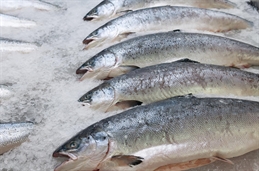
When LATAM Cargo was planning to establish a new routing for perishables exports to Asia via a new US gateway, management hit some unexpected hurdles. In some locations, it could not find the right cooler or the right cold chain, partner. One major gateway could only muster a cooler capable of taking three pallets – a far cry from the load on LATAM’s Boeing 767-300 freighters.
“You don’t expect that in a large airport in the US,” said LATAM Cargo CEO Andres Bianchi.
This experience is in stark contrast with cold chain infrastructure at Dallas Fort Worth International Airport (DFW), where the investment in a sizable cooler was a strategic element.
To position DFW as a transit point for cargo streams between Asia and Latin America, management realized it needed a temperature-controlled facility to handle the perishables coming up from the south. In addition, pharmaceuticals traffic has shown strong growth in the area, which reinforced the need for such infrastructure.
“DFW is the poster child of how to think about these things, upgrading to accommodate all kinds of speciality products like perishables,” said Ray Brimble, CEO of aviation facility developer Lynxs. His company built the cooler facility at Houston’s Bush Intercontinental Airport that was subsequently taken by ground handler DNATA, which also operates the temperature-controlled building at DFW.
He thinks the focus on temperature-controlled cargo facilities is growing around North America. Airports like Halifax and Edmonton have established new cargo terminals with larger coolers over the past couple of years. To a large extent, these developments were driven by rapid growth in perishables exports to China – lobster and other seafood from Halifax, meat and some produce from Edmonton.
The rise in perishables traffic has prompted a growing number of airlines and multinational forwarders to target this traffic. A study of the global perishable goods market published last year predicts 13% CAGR for the years through 2024.
Moreover, yields in this segment have held up well, unlike those for general cargo.
According to IATA, airline cargo yields declined 5% last year. For this year the airline interest group was predicting a further drop of 3%, a forecast made before the advent of the Covid-19 virus.
These factors point to a lively interest in new cooler facilities to support perishables and pharmaceuticals transportation and suggest that more airports should follow in the footsteps of DFW, Houston, Halifax and Calgary.
“Many airports have substandard infrastructure there,” Brimble said.
However, most airports have shown no hurry to join the race. “It’s been quieter than it should be. I’m surprised that there is not more activity,” Brimble said.
Mike Webber, associate vice president of aviation planning and development consultants Landrum & Brown, has seen some initiative on this front, but it usually has not come from the airports. Instead, it is mostly airlines – chiefly hub carriers – that invest in cooler infrastructure and temperature monitoring at their bases. These improvements are usually self-funded and developed, so they do not require the involvement of third-party facility developers like Lynxs, he said.
“In some cases, these investments are defensive because hub carriers derive competitive advantages based on their operating scale that no other carriers in that market can match. Therefore, they don’t want to participate in common use facilities in which they might be supporting facilities that are critical for competitors but would rather just have them in their own facilities. Absent common use refrigeration and other factors required for that business, the non-hub competitors may have to embargo pharmaceutical shipments on certain routes – pushing all that business to the hub carrier,” he added.
Airports like DFW or Miami derive support for general use perishables facilities on their patch from non-hub airlines.
With a substantial presence of international carriers on their turf, they can reach the critical mass necessary to build temperature-controlled warehouses without the endorsement of the dominant hub carriers in these locations, he continued. Hence third-party cold chain infrastructure has developed at and around airports like Miami and Los Angeles.
“DFW may be the most entrepreneurial airport operator in the US,” Webber reflected, adding that Miami and Atlanta are also in that category.
Few other airports have the volume of traffic and number of operators to establish themselves as perishables gateways if they are not led by the dominant hub carrier.
Outside the top North American gateways, few airports can make it, Webber thinks.
There is also the question of what happens if the perishables strategy does not work out. Much of the investment would be lost if a warehouse had to be reconfigured to suit a different purpose.
“The infrastructure needs to be custom-built. Houston has a lot of fish and berries, Miami handles a lot of flowers, at DFW it’s mostly bio-med and pharma traffic. This requires a higher degree of specialization. You can’t just get in a cooler,” said Brimble.
“For many airports and even non-airport commercial developers, the more one customizes a warehouse, the harder it will be to find a comparable replacement tenant if the original tenant fails or moves. Hence, perishables facilities, in which refrigeration and other controls can push development costs exponentially, are high-risk propositions.
Airports that participate in landing fees and other benefits from perishables imports can somewhat balance that risk from a diversified pool of returns. Developers simply collecting rent maybe a little more tenuous,” Webber said.
By Ian Putzger
Air Freight Correspondent | Toronto




